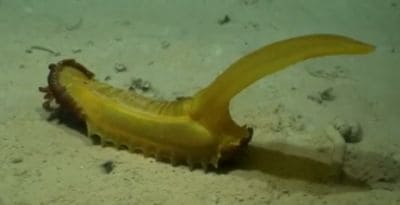Sea Life › Marine › Invertebrate › Echinoderm › Sea Cucumbers › Gummy Squirrel
Interesting Facts about the Gummy Squirrel
[Phylum: Echinodermata] [Class: Holothuroidea] [Order: Elasipodida] [Family: Psychropotidae]
One of the most unusual of all sea cucumbers is commonly known as the "gummy squirrel", a species of deep-sea holothurian within the family Psychropotidae.
This guide contains some little-known information about Psychropotes longicauda, a sea cucumber that looks like a gummy bear with a squirrel-like tail.
Where Do Long-Tailed Sea Cucumbers Live?
Psychropotes longicauda is one of the "abyssal" sea cucumber species that live on the seabed of some of the deepest oceans on the planet.
This deep-sea creature inhabits the soft-sediment ocean floors of some abyssal plains at depths often below 3,000 metres.
For example:
They've been spotted in more than one ocean. But the most significant sightings occurred on the seabed of the Clarion-Clipperton Zone (CCZ), at unimaginable depths in the Pacific Ocean.
Holothuroidea is a classification within the phylum Echinodermata that contains around 1,200 different species of sea cucumber. They are sloth-like scavengers that slowly roam around various benthic zone environments searching for food scraps.
Gummy Squirrel Characteristics
The quirky nickname is one of the funniest fish names invented by marine biologists. Even so, its squidgy gummy-looking appearance, bright yellow colouration, and long sail-like tail, somewhat justifies the cute moniker.
They have a cylindrical body shape with a flattened belly. The most recent results from deep-sea imagery suggest the yellowish upper surface blends into a red under-belly with similar coloured feeding palps.
Here's the thing:
Fully grown adults generally grow to about eighty (80) centimetres long (30 inches), if you include the tail portion.
There are eighteen (18) short, tube-like feeding tentacles located around the mouth and the anterior section (the end that captures food). Psychropotes longicauda use them to capture sinking particles and to sift organic detritus material from the sediment.
But, the striking feature in gummy squirrels is the long dorsal appendage that projects upward from the posterior dorsum. It is the major physical characteristic that distinguishes them from other types of sea cucumber.
Interesting Fact: Some speculation by researchers suggests the thick taillike appendage may actually function as a sail to help them catch weak deep-sea currents. If so, the animal may be able to "bounce" (or be carried) across the seafloor to reach better feeding grounds.
What Do Gummy Squirrels Eat?
Most sea cucumbers are surface deposit feeders because their mouth is located on the underside. Using the short, red feeding tentacles that surround the mouth, they can ingest tiny grains of sand and mud - and detract particles of detritus from them.
 Underneath, they have a double row of tube feet with another separate single row of larger tube feet on either side of their body.
Underneath, they have a double row of tube feet with another separate single row of larger tube feet on either side of their body.
But wait - there's more:
Like most of the crinoidea species, some sea cucumbers can float near the surface, and even swim short distances.
However, Psychropotes longicauda spends most of their lives sifting food from the sea floor.
Bioturbation in some living organisms, such as the northern cirratule (Cirratulus cirratus), is an essential role for the reworking of sediments and recycling of nutrients in ocean floor ecosystems.
Reproduction in Sea Cucumbers
Most species of sea cucumber reproduce by releasing eggs and sperm into the water. Hence, fertilisation happens externally.
Instead of direct mating, they spawn by broadcasting their gametes into the ocean. During the spawning season, sea cucumbers release their eggs and sperm into the water column 'simultaneously' to increase the chances of a successful outcome.
Compared with other types of echinoderms, the buoyant eggs of gummy squirrels are some of the largest, usually measuring more than four (4) centimetres in diameter.
Predators and Threats
There is very little evidence of gummy squirrel predation, including from the grenadiers fish (Macrouridae). In fact, scientists think the presence of some kind of toxic chemical may be enough to deter any potential predators from eating them.
One consequence of living in extreme depths is that Psychropotes longicauda are a challenge to study and to gain accurate information.
However...
We do know that the deep-sea habitats in which they live are rich in polymetallic nodules. These are 'potato-sized' concretions of rare earth metals that are present on the ocean floor.
So, any significant seafloor mining for manganese, copper, or cobalt nodules, and subsequent plumes of sediment, could prove to be disastrous for the long term survival of many deep ocean organisms.
Related Information and Help Guides
- Fun Fact about Echinoderms with Species Examples
- Sand Dollar Facts about Anatomy and Reproduction
- Sea Urchin Phylum and Treatment for Puncture Wounds
- Sea Star Facts and Species Information with Pictures
Note: The short video [3:51 minutes] presented by "Deep Marine Scenes" contains more gummy squirrel sea cucumber facts with some incredible footage of this long-tailed marine invertebrate.